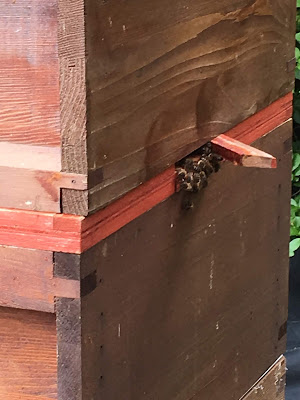 |
| Cell raiser above a Snelgrove board |
There is a comprehensive account on the many uses of a
Snelgrove board on The Welsh Bee Keepers association web site, here: WBKA They explain the methods of using the board for swarm
control and rearing of a new queen plus a few innovative uses too. Here’s my take on
using the board to rear a batch of queen cells:
I came across a colony making swarm preparations early this season. They had sealed
queen cells, as the weather was fine, according to the books they should
have already swarmed but the queen was still present. I was looking to prepare
some cell builders in the next few days and as a colony preparing to swarm is obviously geared up to build queen cells, here was an ideal opportunity to use this colony as a cell raiser and prevent the loss of a swarm. I decided to to use the Snelgrove board to prepare them for taking grafts.
The hive was taken off it's floor and a clean brood box containing 10 frames of foundation put in it's place. The queen on a frame of sealed, emerging brood was placed in the centre of this box, the frame having been checked to ensure that there were no queen cells present. A queen excluder was then placed on this brood box followed by the super (actually another brood box, used as a super to get brood frames drawn out for use in nucleus colonies later in the season). The Snelgrove board covers the supers with all doors shut except one at the side of the hive giving access to the top level.
The brood chamber, two brood boxes as this was on double brood, was checked frame by frame and all queen cells removed. The two boxes then completed the stack.
The hive was taken off it's floor and a clean brood box containing 10 frames of foundation put in it's place. The queen on a frame of sealed, emerging brood was placed in the centre of this box, the frame having been checked to ensure that there were no queen cells present. A queen excluder was then placed on this brood box followed by the super (actually another brood box, used as a super to get brood frames drawn out for use in nucleus colonies later in the season). The Snelgrove board covers the supers with all doors shut except one at the side of the hive giving access to the top level.
The brood chamber, two brood boxes as this was on double brood, was checked frame by frame and all queen cells removed. The two boxes then completed the stack.
 |
| Bees at the top entrance |
On the 8th day after inserting the board I removed all the emergency queen cells that the bees had built. This resulted in a large queen-less colony (two brood boxes above the Snelgrove board) that had lots of emerging young nurse bees, a large foraging force, no larvae to feed and no way for the bees to make a new queen until I gave them some grafted 12-hour old larvae.
By using the Snelgrove board you are separating the queen and flying bees away from the brood as in a standard artificial swarm. When used for swarm control according to the methods described, on day 5 the entrances are switched, diverting recently promoted flying bees from the top queen-less half to the lower queen-rite part of the colony. I was intending to raise a larger number of queen cells. I therefore wanted the top boxes to remain strong in numbers of bees and so did not carry out this step.
I grafted from one of my breeder queens late on the ninth day, inserting eight cell cups next to a pollen frame in the centre of the top brood box.
Two days after inserting the grafts I checked the grafts for acceptance, the cells are
well on their way, being tended by many nurse bees.
Five days later all the queen cells are capped, and I
diverted some of the foraging force to the lower colony. This would now boost the strength of the lower colony.
The result:
Seven out of eight grafts, almost 90%, that's probably my best rate of takes so far.
The result:
 |
| Ripe queen cells |
Now just the small matter of getting these new queens mated.
No comments:
Post a Comment